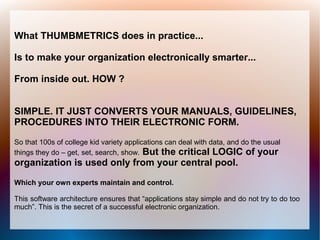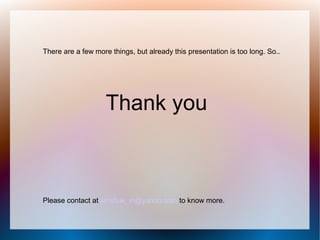Smart Housekeeping Apps
- 1. Building smart organizations with... Logic driven applications Welcome to this presentation. This may require unconventional thinking.
- 2. This presentation is about SIMPLE software applications. ’ü¼ About housekeeping applications. Leave records, time keeping, personnel rules. Task and time trackers. Project planning. ’ü¼ Organizational metrics. Performance guidelines. Policies. Maybe even material movements, logistics. This presentation is also about making software applications SIMPLE . Impatient people can first view a demo on ŌĆ£Organizational MetricsŌĆØ. Please visit Thumbmetrics Play with its menu and watch some screens. The next few slides explain why such an application is a cure for many evils. And why many so-called world class applications built in the 2000-2008 - cannot match its simplicity and elegance.
- 3. First, some historical perspectives... In the 60's and the 70's, computers began to be used in organizations, government, and defence. But people ŌĆ£thoughtŌĆØ differently when making them. COBOL was used a lot. The people who wrote those applications were computer science experts, often with Masters and PhD degrees. Many people in those days wrote extremely powerful languages ŌĆō artificial intelligence languages, many still in use where things really matter. People called them ŌĆ£programsŌĆØ. The focus was mostly on ŌĆ£logicŌĆØ. The data was stored in ŌĆ£filesŌĆØ. Any kind of files. People worried a lot about ŌĆ£proceduresŌĆØ. THIS is a very important point to appreciate. Logic, vs data. But in the 90's and 2000's, business applications began to concentrate more and more on ŌĆ£dataŌĆØ. The logic part became often trivial. Data was everything. It does not take much ŌĆ£logicŌĆØ to sell potato chips. So the small amount of logic was often mixed up within the data's get-set-read-write processes. Between 2000 to 2008 ŌĆō the diffcult areas of data handling were all solved. It became very easy and trivial to build data-centric applications. So much so that code generators became available, and any college going person can now build applications in minutes of the kind that often took months to build in 2000. Many vendors are actually selling apps made prior to this. In 2010, many people are again beginning to look more closely into the ŌĆ£logicŌĆØ, and treat the data as a secondary aspect of organizational applications.
- 4. Data Logic ’ü¼ Numbers ’ü¼ What if ? Search ’ü¼ Text ’ü¼ When ? Show ’ü¼ Records ’ü¼ If-then-else Ask Write ’ü¼ Documents ’ü¼ Steps Use ’ü¼ Files ’ü¼ Processes ’ü¼ Books/pages ’ü¼ Procedures ’ü¼ Manuals ’ü¼ Policies Questions to you : Does data and logic look like the same ŌĆ£thingsŌĆØ ? Should they be mixed up in the same place ? You will be surprised to know that very few applications in the world keep them separately. Because it takes pains to do that. Care and concern. And this is the root cause of so much organizational misery later on. It is very important that Indians do not make the same mistakes.
- 5. Who am I to speak of such things :-) Just to get things in order : I am a 47 year old IIT graduate, with about 12 years of software (biz application building) experience, and a prior 12 years of chemical engineering experience. To continue : So, why exactly are people looking for a ŌĆ£new way to build common applicationsŌĆØ ? Because after 3-5 years, an electronic organization resembles a ŌĆ£noodleŌĆØ. The more successful they are/were, the more complex the noodle becomes. After 5 years of ŌĆ£successfulŌĆØ IT, people seriously question the beginings. They often discuss something called ŌĆ£enterprise architectureŌĆØ. Which, in this world of jargon, is just a label (and some white papers) with very little real practitioning behind it. There are many other such jargon terms. BI, SaaS, BPM, x, y and z. To the practitioners they mean something, and to the sales people, something else. The software world, since Y2K, has learned that it is easy to fool people of other disciplines when backed by media propaganda and the internet.
- 6. What they get after 5 years ... V People apps Financial apps Homemade apps E N Frustrated Factory apps Purchase apps Vendor apps bosses, D employees, users Sales apps Document systems Staff apps O R Project apps Time-task trackers KPI apps S E-learning apps BI apps What they actually want ... Bosses Commands, guidelines, rules, policies, procedures Communication bus ŌĆō with easy hook up from any-to-any Simple app 1 Simple app Simple app Simple app Simple app 5
- 7. THIS PRESENTATION, IS ABOUT THIS PART Bosses Commands, guidelines, rules, policies, procedures This below part is called an ESB. About that we can talk later. Communication bus ŌĆō with easy hook up from any-to-any And the last part can be built by any college kid. Using code generators that cost about 50$. If you do not believe me, ask your college going kid. This is 2010. Many vendors sell the same stuff :-) Simple app 1 Simple app Simple app Simple app Simple app 5
- 8. A few questions about your ŌĆ£electronicŌĆØ organization : Lets say there are a 100 applications that your organization uses (a very typical number in any large corporation). Question 1. : You declare that ŌĆ£The 4th Saturday of every alternate month will, from now onwards, be a working dayŌĆØ. So ŌĆō leaves will be counted, time-sheets must be filled, man-hours will get added, and the warehouse can record movements. So ŌĆō how many of your software applications will start applying this immediately ? Most likely they wont, because ŌĆ£what is a holiday ?ŌĆØ is something they have decided, in their infinite wisdom, to store inside their own application. Question 2. : If yours is a ŌĆ£knowledge organizationŌĆØ, then, do you know where the best and the most used pieces of your knowledge, created by your best experts ŌĆō really is ? If you answered ŌĆ£ExcelŌĆØ - I will believe you. The whole world over, most experts store their best knowledge in Excel or Excel type spreadsheets. Because ŌĆ£usersŌĆØ are smart. Smarter than their IT folks and vendors. They do not get confused between ŌĆ£dataŌĆØ and ŌĆ£logicŌĆØ. They have discovered the ideal location for ŌĆ£individual knowledgeŌĆØ. But sadly, spreadsheets are not the ideal place for ŌĆ£organizational knowledgeŌĆØ.
- 9. In their search for ŌĆ£command and controlŌĆØ, some large organizations look at options like ŌĆ£ERPŌĆØ All business processes in a single central application. A nice DREAM. IF ŌĆō the vendor has spent between 3 to 20 years revising the application, discovering defects and correcting them, then there is still hope. Only in a ŌĆ£limited area of operationsŌĆØ. With year long ŌĆ£customizationsŌĆØ. Customizations fight a constant duel against ŌĆ£real worldŌĆØ. There is a limit to how much you can ŌĆ£customizeŌĆØ, given a fixed set of ŌĆ£modelsŌĆØ. I have heard phrases like this one (after 5-6 years of implementation) - ŌĆ£we wrote so much customized code, we could have written that damn ERP ourselves in-houseŌĆØ. Very often customizations just run out of all options. Then the vendor supplies ŌĆ£APIsŌĆØ. Which means - ŌĆ£please use these APIs and write your own simple apps yourself, we cannot do everythingŌĆØ. Just use our database, that is all we ask :-) Which brings us to the ŌĆ£SIMPLE APPSŌĆØ of the previous slide, does'nt it ? Made by the college kid, remember ?
- 10. What does THUMBMETRICS demonstrate ? The obvious things 1. This is what ALL internet based applications (post 2010) should work like. No page refreshes, and fast VB like responses. 2. No frills. A single place to do everything from, a 1000 things from a single menu system. For a new generation that is not impressed with artistic pages. Less obvious things 3. But actually, the screens are not needed at all. Thumbmetrics is meant (in a real scenario) ŌĆō to work without any screens at all. 4. It is meant to ŌĆ£talkŌĆØ to other applications over the internet. ŌĆō The ŌĆ£ExportŌĆØ button shows how : any application, from anywhere in the world, can connect and use Thumbmetrics effortlessly. How many vendor applications have these ŌĆ£featuresŌĆØ ?
- 11. The ŌĆ£hiddenŌĆØ aspects of THUMBMETRICS - 1 1. It is not a single ŌĆ£applicationŌĆØ. It is a demo for a ŌĆ£classŌĆØ of applications, a methodology that smart enterprises will eventually adopt. 2. Thumbmetrics inverts the electronic organization from this : Lo DATA Lo gi gic c to this : D LOGIC Da at ta a 3. Thumbmetrics represents the knowledgebase (not the database), of your organization.
- 12. The ŌĆ£hiddenŌĆØ aspects of THUMBMETRICS - 2 1. In Thumbmetrics, you can create, enter a new rule, policy, formula, logic in a matter of minutes. (this feature is not visible in the demo version). 2. And immediately, all your other applications can use this new logic, from anywhere across the world. (for example, the new guideline on the 4th Saturday holidays). 3. In many of its internal aspects, it is far closer to an Excel type spreadsheet. Users will find it reasonably easy to switch from one to the other ŌĆō thus in effect creating their own set of logics and bits of knowledge. Who knows the most about your organization, each department, its real workings ? IT IS YOU ! Your users, your departmental heads, your experts. And this simple thing is what ALL vendors hope you will not mention. Vendors claim to have ŌĆ£domain knowledgeŌĆØ [ another jargon]. The reality is, unless they have spent 3-12 years in the business, they are just guessing.
- 13. What THUMBMETRICS does in practice... Is to make your organization electronically smarter... From inside out. HOW ? SIMPLE. IT JUST CONVERTS YOUR MANUALS, GUIDELINES, PROCEDURES INTO THEIR ELECTRONIC FORM. So that 100s of college kid variety applications can deal with data, and do the usual things they do ŌĆō get, set, search, show. But the critical LOGIC of your organization is used only from your central pool. Which your own experts maintain and control. This software architecture ensures that ŌĆ£applications stay simple and do not try to do too muchŌĆØ. This is the secret of a successful electronic organization.
- 14. Being an experienced manager, these below points may seem interesting to you : 1. The procedure manuals, rule books of your department ŌĆō have been often created with a 100 years of wisdom (for example, government departments). They represent copies of copies of the wisdom of experienced managers who have come before you. No vendor can claim to express all of that in ŌĆ£one single all-encompassing application created in a 3 year time-frame with low cost developersŌĆØ. 2. The procedure manuals are not written in stone, They undergo changes, sometimes immediate, mostly well deliberated. 3. Thumbmetrics type scenarios eventually create the ŌĆ£brainsŌĆØ of the organization. Data type applications create the ŌĆ£memoryŌĆØ. 4. One can never expect ŌĆ£finished piecesŌĆØ in such things. They grow. Thumbmetrics is not a finished piece. It expects to grow ŌĆō but by your own in-house people. 5. The pull-and-push in the data-vs-logic is a healthy thing. The smartness arrives in both over time. It is unwise to have single applications that claim to have both. 6. You do not ŌĆ£buyŌĆØ things like Thumbmetrics off the shelf. It is like buying a Word document. But you can use the idea to build smart things.
- 15. There are a few more things, but already this presentation is too long. So.. Thank you Please contact at kinshuk_in@yahoo.com to know more.

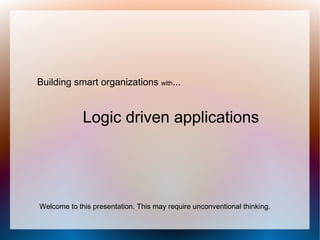

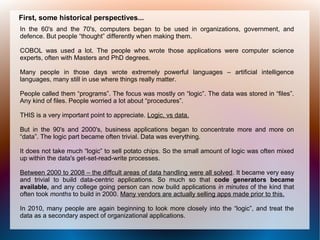

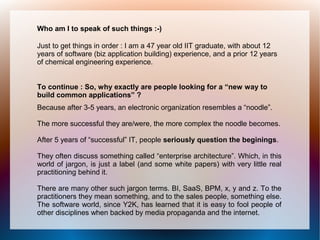
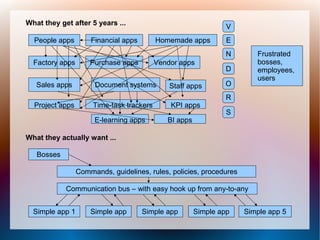

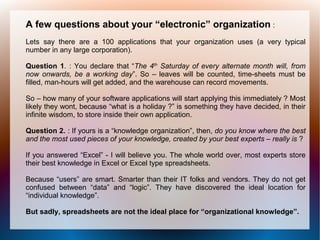
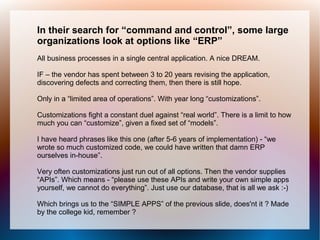
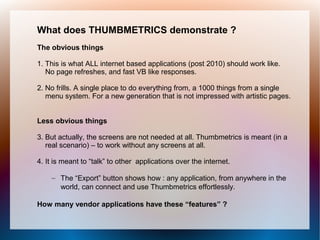
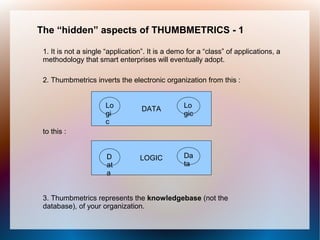
![The ŌĆ£hiddenŌĆØ aspects of THUMBMETRICS - 2
1. In Thumbmetrics, you can create, enter a new rule, policy, formula, logic
in a matter of minutes. (this feature is not visible in the demo version).
2. And immediately, all your other applications can use this new logic, from
anywhere across the world. (for example, the new guideline on the 4th
Saturday holidays).
3. In many of its internal aspects, it is far closer to an Excel type spreadsheet.
Users will find it reasonably easy to switch from one to the other ŌĆō thus in
effect creating their own set of logics and bits of knowledge.
Who knows the most about your organization, each department, its
real workings ?
IT IS YOU ! Your users, your departmental heads, your experts.
And this simple thing is what ALL vendors hope you will not mention.
Vendors claim to have ŌĆ£domain knowledgeŌĆØ [ another jargon]. The reality is,
unless they have spent 3-12 years in the business, they are just guessing.](https://image.slidesharecdn.com/smarthousekeeping-12693379287183-phpapp02/85/Smart-Housekeeping-Apps-12-320.jpg)
